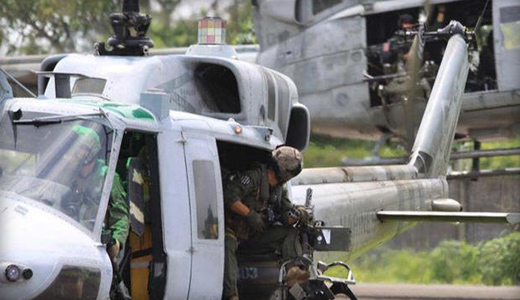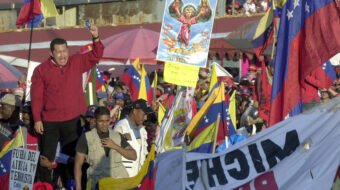
Honduran military authorities announced March 27 that some 250 U.S. Marines arriving soon will be based at the U. S. airbase at Soto Cano. Equipped with a high-speed “JHSV Spearhead” catamarans at least four “CH-53E Super Stallion” helicopters,” and possibly “MV-22 Osprey tilt rotors and KC-130 Hercules tankers,” they are part of the “Special Purpose Marine Air-Ground Task Force-South.”
The official version of their mission is to carry out “training for forces in the region, humanitarian assistance missions, and anti-drug operations.”
The SPMAGTF, based at Camp Lejeune, North Carolina, is part of Marine Expeditionary Force II. According to the Marine Corps’ web site, a “MEF possesses the capability for projecting offensive combat power ashore while sustaining itself in combat without external assistance for a period of 60 days. A similar [Marine Corp] expeditionary force is based at Moron Air Base in Spain as support for the U.S. Africa Command.
The announcement of the Marines’ arrival coincided with the opening in Tegucigalpa of the Central American Regional Security Conference. The official purpose was to build a “shield against organized crime.” Honduran President Juan Orlando Hernandez welcomed the gathering of military, intelligence and drug-war officials from 14 nations. U.S. Marine General John Kelly, commander of the U.S. Southern Command, told attendees that, “There is a large contingent of U.S. officials here … Ms. Erin Logan is here from the White House. … [T]his is the first time we’ve had someone from the White House, at that high a level, attend this conference.” The region is among President Obama’s “top four national security and national policy priorities.”
The Soto Cano airbase has been emblematic of the U.S. military’s long presence in Honduras. It’s home-base for 500 U.S. troops and was the organizational center for U.S. support for the anti-Sandinista Nicaraguan Contras in the 1980’s. Critics of a U.S. role in the 2009 military coup that overthrew elected President Manuel Zelaya often cite the Soto Cano base. They point to the stopover there of the plane carrying Zelaya from the capital to exile in Costa Rica.
Others displeased with the U.S. military presence in Honduras note the recent construction there of three Navy bases costing millions of dollars . Defense Department officials have identified Honduras as the center for U.S. military communications in Central America and drug – interdiction efforts. The country, which claims one of the highest murder rates in the world, is in fact a way station for illicit drugs moving from south to north.
Condemnation of the outsized U.S. military presence in Latin America and the Caribbean is not new. In that vein, former Colombian President Ernesto Samper, no radical, recently proposed the elimination of all U.S. military bases in the region; they are a left-over of “the cold war epoch, he said. Samper was speaking on behalf of the Union of South American Nations (UNASUR), established in 2008 to promote continental unity and political and economic cooperation. Samper is the UNASUR’s secretary general. He wants his proposal on the agenda of the upcoming Summit of the Americans set for Panama Apr. 10-11.
He could have been thinking of the report in mid-March that some 3,500 U. S. Marines will be deployed to Peru over the next year for either short or long stays. Peruvian spokespersons say they will be training Peruvian counterparts for drug-war missions. There are hints however, as to counter-insurgency purposes for the U.S. troops and references to Peru’s strategic location between Bolivia and Ecuador, each with a leftist government .
These recent developments will hardly smooth the way for President Obama at the upcoming Summit of the Americas. He’s already fending off criticism of the U.S. sanctions against Venezuela that he announced on Mar. 9.
And to have old-timers in U.S. governing circles speculating about Colombia’s future military needs, especially as regards Venezuela, complicates matters for the president. Former New York Mayor Rudolph Giuliani and former State Department, CIA, and NSA official Mary Beth Long recently attended a meeting in Bogota called by the Colombian Defense Minister Pinzon and attended by President Juan Manuel Santos. Ostensibly they were helping the Colombians plan a role for their military after any peace agreement with FARC insurgents takes effect.
At a press conference on Mar. 28, Long said she was pleased the Colombian “military is studying other threats in the region represented by their neighbors, like Venezuela.” Giuliani opined that, “local crime is terrible but it’s much better than to have to be concerned about the FARC and drug-traffickers taking over the government.”
Interviewed later, Giuliani foresaw the Army fighting “other lawless groups.” He advised that neither the size nor the budget of Colombia’s military be reduced. Venezuela, he said, “is like a true tragedy [with things] going from bad to worse.”
Photo: In this photo U.S. Marine helicopter and troops involved in operations in Guatemala in 2012. | AP/U.S. Marine Corps.












Comments